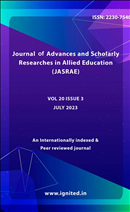Unlocking Emotions in Text: A Comprehensive Study of Computational Linguistics and Natural Language Processing Techniques
Keywords:
Emotions, Feelings, Social Networking Data, Vectorization, Single Layer Feedforward Network (SLFN), Digital Communication, Emotionally Intelligent Computer SystemsAbstract
The widespread use of digital communication has led to the creation of vast amounts of written content every day. Understanding the emotions expressed in this data is crucial for the development of emotionally intelligent computer systems. This article presents the development of a novel approach, known as CLBEDC-SND, which aims to recognise and classify Social networking data containing sentiments. Numerous phases of data pre-processing were performed on the CLBEDC-SND model to guarantee its suitability for subsequent processing. The CLBEDC-SND model undergoes sentiment scoring and vectorization utilising a fuzzy methodology. Vectorization is the conversion of textual information into a vector representation, which may be used with the ELM model. The ELM model was utilised by the CLBEDC-SND model to provide accurate and timely emotion categorization. The procedure selects the input weight in a random manner and computes the output weight of the Single Layer Feedforward Network (SLFN) using empirical data. Subsequently, the starting weight of the input and the bias of the hidden layer are chosen at random. Using the SFLO method, the parameters of the ELM model are optimised in the final stage. The study data demonstrated that the CLBEDC-SND method consistently yielded enhanced outcomes across all domains. A comprehensive comparison analysis will be done to improve the precision of emotion categorization results produced from the CLBEDC-SND model. The experimental evaluations have demonstrated that the CLBEDC-SND model outperforms alternative models in its ability to classify emotions. The enhanced performance of the CLBEDC-SND model can be ascribed to the integration of sentiment scoring based on fuzzy logic and the optimum parameter modification strategy based on SFLO. Thus, the proposed model is applicable.
References
Acheampong, F. A., Wenyu, C., & Nunoo‐Mensah, H. (2020). Text‐based emotion detection: Advances, challenges, and opportunities. Engineering Reports, 2(7), e12189.
Ahire, V., & Borse, S. (2022). Emotion detection from social media using machine learning techniques: a survey. In Applied Information Processing Systems: Proceedings of ICCET 2021 (pp. 83-92). Springer Singapore.
Alnuaim, A. A., Zakariah, M., Shukla, P. K., Alhadlaq, A., Hatamleh, W. A., Tarazi, H., ... & Ratna, R. (2022). Human-computer interaction for recognizing speech emotions using multilayer perceptron classifier. Journal of Healthcare Engineering, 2022.
Azam, N., Tahir, B., & Mehmood, M. A. (2020). Sentiment and emotion analysis of text: A survey on approaches and resource s. Language & Technology, 87.
Bharti, S. K., Varadhaganapathy, S., Gupta, R. K., Shukla, P. K., Bouye, M., Hingaa, S. K., & Mahmoud, A. (2022). Text-Based Emotion Recognition Using Deep Learning Approach. Computational Intelligence and Neuroscience, 2022.
Cao, L., Peng, S., Yin, P., Zhou, Y., Yang, A., & Li, X. (2020, December). A survey of emotion analysis in text based on deep learning. In 2020 IEEE 8th International Conference on Smart City and Informatization (iSCI) (pp. 81-88). IEEE.
Chopade, C. R. (2015). Text based emotion recognition: A survey. International journal of science and research, 4(6), 409-414.
Ekman, P. (1999). Basic emotions. Handbook of cognition and emotion, 98(45-60), 16.
Ghazi, D., Inkpen, D., & Szpakowicz, S. (2015). Detecting emotion stimuli in emotion-bearing sentences. In Computational Linguistics and Intelligent Text Processing: 16th International Conference, CICLing 2015, Cairo, Egypt, April 14-20, 2015, Proceedings, Part II 16 (pp. 152-165). Springer International Publishing.
Graterol, W., Diaz-Amado, J., Cardinale, Y., Dongo, I., Lopes-Silva, E., & Santos-Libarino, C. (2021). Emotion detection for social robots based on NLP transformers and an emotion ontology. Sensors, 21(4), 1322.
Hasan, M., Rundensteiner, E., & Agu, E. (2019). Automatic emotion detection in text streams by analyzing twitter data. International Journal of Data Science and Analytics, 7, 35-51.
Mohammad, S. M., & Bravo-Marquez, F. (2017). WASSA-2017 shared task on emotion intensity. arXiv preprint arXiv:1708.03700.
Mustakim, N., Rabu, R., Mursalin, G. M., Hossain, E., Sharif, O., & Hoque, M. M. (2022, May). CUET-NLP@ TamilNLP-ACL2022: Multi-Class Textual Emotion Detection from Social Media using Transformer. In Proceedings of the Second Workshop on Speech and Language Technologies for Dravidian Languages (pp. 199-206).
Nandwani, P., & Verma, R. (2021). A review on sentiment analysis and emotion detection from text. Social Network Analysis and Mining, 11(1), 81.
Plutchik, R. (2001). The nature of emotions: Human emotions have deep evolutionary roots, a fact that may explain their complexity and provide tools for clinical practice. American scientist, 89(4), 344-350.
Rodriguez, A., Chen, Y. L., & Argueta, C. (2022). FADOHS: framework for detection and integration of unstructured data of hate speech on facebook using sentiment and emotion analysis. IEEE Access, 10, 22400-22419.
Sailunaz, K., Dhaliwal, M., Rokne, J., & Alhajj, R. (2018). Emotion detection from text and speech: a survey. Social Network Analysis and Mining, 8, 1-26.
Seal, D., Roy, U. K., & Basak, R. (2020). Sentence-level emotion detection from text based on semantic rules. In Information and Communication Technology for Sustainable Development: Proceedings of ICT4SD 2018 (pp. 423-430). Springer Singapore.
Singh, D., Kumar, V., Kaur, M., Jabarulla, M. Y., & Lee, H. N. (2021). Screening of COVID-19 suspected subjects using multi-crossover genetic algorithm based dense convolutional neural network. IEEE Access, 9, 142566-142580.
Suhasini, M., & Srinivasu, B. (2020). Emotion detection framework for twitter data using supervised classifiers. In Data Engineering and Communication Technology: Proceedings of 3rd ICDECT-2K19 (pp. 565-576). Springer Singapore.
Zad, S., Heidari, M., James Jr, H., & Uzuner, O. (2021, May). Emotion detection of textual data: An interdisciplinary survey. In 2021 IEEE World AI IoT Congress (AIIoT) (pp. 0255-0261). IEEE.











